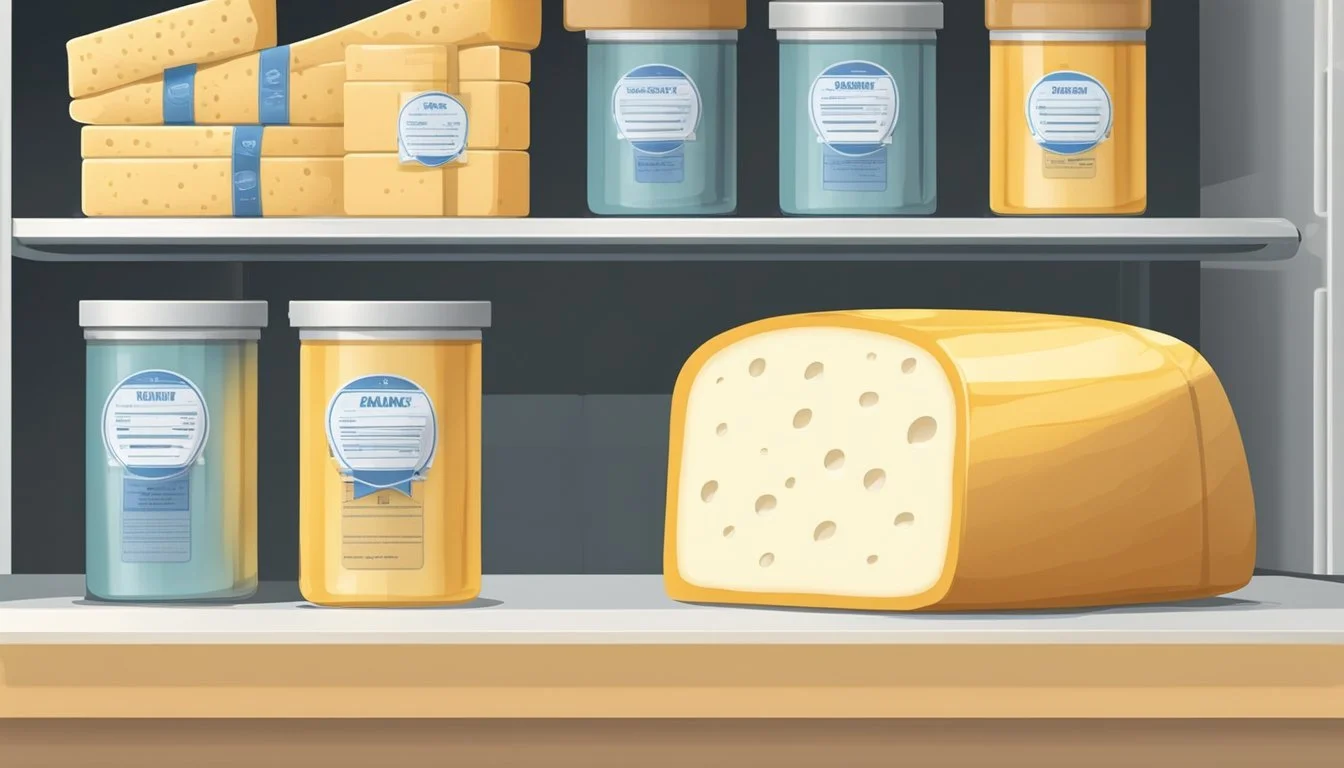How Long Does Provolone Last?
Shelf Life and Storage Tips
Provolone cheese, known for its versatility in sandwiches (What wine goes well with sandwiches?), pizzas, and a variety of cooked dishes, also boasts a relatively stable shelf life compared to other cheeses. In the refrigerator, an unopened block of provolone cheese can last for 2 to 3 months while maintaining quality. Once opened, its shelf life decreases, and consumers can expect it to stay fresh for about 3 to 4 weeks if kept in the proper conditions at or below 40°F.
Freezing provolone cheese can extend its longevity. When placed in freezer-safe packaging, provolone can be preserved for about six months without significant compromise to flavor and texture. However, for ideal quality and taste, using it within six weeks to two months is recommended. Proper storage is key; provolone should be in tightly sealed, airtight containers, or firmly wrapped in plastic wrap or aluminum foil to keep out moisture and other contaminants.
The cheese's condition can be determined by its smell and appearance. Provolone does not naturally have an overpowering scent, so any strong, sour smell would indicate spoilage. Similarly, the presence of mold or a noticeably altered texture suggests that the cheese is past its prime and should no longer be consumed.
Provolone Cheese Fundamentals
The key aspects of Provolone cheese involve its unique characteristics and its rich heritage, including its origin, variations, and distinguished flavor profile.
Characteristics of Provolone
Provolone cheese is an Italian semi-hard cheese known for its smooth texture and taste that ranges from mild to sharp, depending on the aging process. The flavor profile can be described as somewhat similar to mozzarella, yet with its own distinct twist. Aged Provolone delivers a sharper and more robust taste, while the mild versions are subtler and softer in flavor. Additionally, a variant of Provolone cheese is smoked to enhance its depth of flavor, adding a smoky note to the cheese's taste.
Origin and Types
Provolone cheese originates from the Po Valley region in Italy, and it is there that this cheese has been crafted and perfected over time. There are two main types of Provolone: Provolone Piccante, which is aged for a longer period and has a sharp, strong flavor, and Provolone Dolce, which is aged for a shorter time to maintain a mild taste. The aged varieties, in particular, are prized for their fuller flavor and firmer texture, qualities that become more pronounced with time.
Storage Guidelines
Proper storage is crucial for maintaining the quality and extending the shelf life of provolone cheese. It involves maintaining the right temperature, using suitable packaging, and understanding the impact of freezing.
Refrigeration Essentials
Provolone cheese should be stored in the refrigerator at a consistent temperature of 35°F to 40°F (1.7°C to 4.4°C). This temperature range is optimal as it inhibits bacterial growth and helps the cheese maintain its moisture and flavor.
Freezing Techniques
To freeze provolone cheese, one should wrap it in plastic wrap or aluminum foil and then place it in an airtight container. Frozen provolone will last for six weeks to two months, but it's important to cool it down below 32°F (-0°C) within four hours to ensure quality.
Shelf Life Determination
The shelf life of provolone cheese can vary:
Unopened in the refrigerator: Up to two months
Opened in the refrigerator: 1 to 3 weeks
Frozen: 6 weeks to 2 months
Expiration dates should be checked regularly to ensure consumption within a safe timeframe.
Packaging for Freshness
To retain freshness after opening, provolone cheese must be tightly wrapped in plastic wrap or aluminum foil. Alternatively, storing it in an airtight container is recommended. Proper packaging prevents drying out and exposure to other flavors in the refrigerator.
Indicators of Quality and Spoilage
Provolone cheese's quality and spoilage can be determined by a combination of visual, olfactory, and texture indicators. Identifying these signs is crucial to ensure the cheese is safe to consume and still possesses its characteristic flavor.
Visual Inspection
When inspecting provolone cheese for freshness, one should look for a consistent yellowish-white hue. Signs of spoilage include darkening, discoloration, or off-color spots, which can indicate mold growth or other forms of deterioration. Visible mold, especially if it is not part of the cheese's original characteristics, should be considered an immediate indicator of spoilage.
Olfactory Signs
The smell of provolone cheese is a reliable indicator of its condition. Fresh provolone should have a mild, savory aroma. An off smell, which can be described as sour or ammonia-like, often signifies bacterial growth and spoilage. Such olfactory signs should be taken as clear warnings not to consume the cheese.
Texture Assessment
A proper check on texture involves noting the cheese's surface and consistency. Fresh provolone is semi-soft and pliable. If the cheese feels hard, dry, or has a slimy texture, these are signs that it has gone bad. Texture changes usually accompany visual and olfactory indicators, providing further confirmation of spoilage.
Health Concerns
Spoiled cheese should not be consumed as it can pose health risks, including the possibility of foodborne illnesses caused by bacteria. If indicators of spoilage such as mold growth, discoloration, or an off smell are present, it is safer to discard the cheese to avoid potential health hazards.
Usage and Culinary Applications
Provolone cheese is versatile in the culinary world, often used for its ability to enhance flavor and texture in dishes. It is known for its mellow flavor and excellent melting qualities, making it a popular choice for a variety of recipes.
Incorporating Provolone in Dishes
Provolone can elevate many dishes due to its distinct taste and melting properties. It is particularly favored in sandwiches, such as the classic submarine sandwich where its mild yet tangy presence complements both meats and vegetables. In baking, Provolone's ability to ooze when melted makes it ideal for stuffed bread and calzones.
Key Dishes:
Submarine sandwiches
Stuffed bread
Calzones
Pizza
Provolone as a Cooking Ingredient
When used in cooking, Provolone cheese adds a creamy and gooey texture that is particularly desired in hot dishes. It's a common ingredient in baked pasta, where it provides a stringy, enjoyable mouthfeel. Interestingly, Provolone can also be used as a complementary or substitutive protein source in vegetarian recipes, giving them richness and depth of flavor.
Common Uses:
Baked pasta like lasagna
Vegetarian dishes (What wine goes well with vegetarian dishes?)
Casseroles
Pairing with Foods
On a cheeseboard, Provolone's mild nature allows it to pair well with a variety of flavors, from the sweetness of fruits like figs and grapes to the salty bite of olives and cured meats (What wine goes well with cured meats?). It harmonizes on a platter with other cheeses such as mozzarella and cheddar, creating a balanced assortment ideal for any appetizer or cheese platter. Accompaniments often include crackers and nuts, contributing to a diverse texture and taste experience.
Cheeseboard Pairings:
Fruits: Figs, Grapes
Others: Olives, Cured Meats, Crackers, Nuts
Cheeses: Mozzarella, Cheddar
Experience the ease of having provolone cheese delivered right to your door when you shop online!
Special Storage Considerations
When it comes to Provolone cheese, maintaining the correct humidity and temperature is crucial whether the product is sliced, shredded, unopened, or opened. Specific storage methods can greatly extend the shelf life and preserve the cheese's flavor and texture.
Handling Sliced and Shredded Provolone
Sliced Provolone Cheese should be stored with care to prevent it from drying out. They recommend placing the cheese in a dedicated cheese drawer that maintains consistent humidity. This drawer is typically located in the refrigerator where the temperature ranges between 35°F to 40°F (1.7°C to 4.4°C). If a cheese drawer is not available, sliced Provolone can be wrapped in parchment paper and then loosely in plastic wrap to allow the cheese to breathe while retaining moisture.
For Shredded Provolone Cheese, which is more susceptible to drying due to increased surface area, it is vital to store it in an airtight container or a resealable plastic bag. This helps to lock in moisture and prevent the cheese from absorbing strong odors present in the refrigerator. The airtight container should then be placed in the coldest part of the fridge, making sure that it's not exposed to fluctuations in temperature which can lead to spoilage.
Caring for Unopened and Opened Packages
Unopened Provolone Cheese has a longer shelf life due to its sealed environment that protects it from external elements. It should be stored in the refrigerator, preferably in the lower section where the temperature remains stable. The original packaging provides a suitable barrier to moisture and other contaminating flavors.
Once the packaging is opened, Provolone cheese requires more attentive care. The opened cheese should be wrapped tightly in plastic wrap or aluminum foil to minimize exposure to air and humidity, which can speed up the degradation process. If it's not consumed within a reasonable time frame, considering freezing the cheese is a practical option, but be aware that this can alter the texture, making it more crumbly upon thawing.
Freezing and Thawing Processes
Freezing provolone cheese can extend its shelf life, while proper thawing ensures it retains its quality. It's crucial to prevent freezer burn and to use appropriate methods for thawing.
How to Freeze Provolone
To freeze provolone cheese:
Prepare: For slices or shredded cheese, spread them out on a baking tray lined with parchment paper.
Flash Freeze: Place the tray in the freezer for about 30 minutes until the cheese is solid to prevent clumping.
Package: Transfer the cheese to a heavy-duty freezer bag or an airtight container.
Remove Air: Expel as much air as possible to minimize the risk of freezer burn, using a rolling pin or a vacuum sealer.
Label: Clearly mark the bag or container with the date of freezing.
Thawing After Freezing
To thaw frozen provolone cheese:
Refrigerator Method: Shift the frozen cheese to the refrigerator and allow it to thaw gradually overnight. Blocks may require up to 24 hours, whereas slices or shredded cheese will thaw faster.
Usage: Once thawed, it's best to consume the cheese within 3-4 days to ensure the best quality and flavor.
Microwave Method: If immediate use is necessary, thaw provolone in the microwave using 30-second intervals at the lowest setting. However, this can affect texture and quality.
When following these steps, one can successfully freeze and thaw provolone cheese without compromising its texture and flavor significantly.
Health and Nutrition Information
Provolone cheese serves as a significant source of several nutrients, contributing to a balanced diet. It provides essential proteins, vitamins, and minerals necessary for maintaining good health.
Nutritional Components
Provolone cheese is known for its high protein content, with approximately 26 grams of protein per 100 grams of the cheese. This amount of protein can help in muscle maintenance and repair, and also aid in slowing carbohydrate absorption which benefits blood sugar control. The cheese is also rich in calcium, offering about 16.5% of the recommended daily value in a single ounce (28.35g) serving. This mineral is crucial for maintaining strong bones and teeth.
In terms of vitamins, Provolone provides a generous amount of Vitamin B12, essential for brain health and the production of red blood cells. It also contains Vitamin A, important for immune function, vision, and skin health. As for sodium, the content can vary by brand, but it is typically considered high, making it a point of consideration for those monitoring their salt intake.
Lactose Content and Allergies
While cheese is a dairy product, during the cheese-making process, most of the lactose is removed. Provolone cheese typically contains very little lactose, making it potentially suitable for individuals with mild lactose intolerance. However, those with a severe lactose allergy or intolerance should still exercise caution and possibly avoid it or choose a lactose-free alternative.
Regarding allergies, individuals with a sensitivity to cow's milk or a related allergy should avoid provolone, as it is made from cow's milk and contains milk proteins that can trigger allergic reactions.
Culinary Alternatives
When it comes to Provolone cheese, chefs and home cooks alike find its distinctive flavor and meltability makes it a staple in various dishes. However, there are suitable substitutes that can be used in its absence, each offering different textures and flavor profiles suitable for a variety of recipes.
Cheese Substitutions
Mozzarella: For pizzas and sandwiches, low-moisture mozzarella provides a similar stretch and mild flavor.
Cheddar: With its sharp taste, cheddar is an excellent substitute in sandwiches and salads to add depth.
Swiss Cheese: Options like Emmental or Gruyère, which are medium-hard, offer a sweet and aromatic flavor that works well in hot dishes.
Versatility in Recipes
Pasta: Fontina and mozzarella can be used in lieu of Provolone to achieve the desired creamy consistency.
Salads: Sharp cheeses like cheddar add a robust flavor when Provolone is unavailable.
Sandwiches: Swiss varieties or Gouda offer a complementary taste and melt well for toasted sandwiches.
Provolone's versatility makes it a go-to ingredient, but these substitutes ensure your dishes maintain their integrity in both flavor and appearance when Provolone is not an option.
Preservation Techniques
Effective preservation techniques for Provolone cheese are vital in extending its shelf life and retaining its freshness and taste. These methods involve controlling the aging process and environmental factors, ensuring that the cheese maintains its quality for as long as possible.
Aging and Maturation
Provolone, a type of hard cheese, benefits from an aging process that enhances its flavor and texture. The duration of aging impacts the shelf life, with aged Provolone typically lasting longer than its younger counterparts due to lower moisture content which reduces spoilage risks.
Controlling Environmental Factors
To preserve Provolone's freshness, controlling storage conditions is essential. The cheese requires a cool and humid environment, optimally stored at temperatures ranging from 40°F to 50°F (4°C to 10°C). Provolone should be kept away from air exposure to prevent drying out and spoiling. For optimal storage, experts recommend:
Wrapping the cheese tightly in plastic wrap or aluminum foil.
Storing in an airtight container to shield it from other flavors and odors.
If freezing, ensuring the cheese is cooled down to below 32°F (-0°C) within four hours and used within six weeks to two months to enjoy its best quality. However, it should be noted that freezing may alter the cheese's texture and melt properties.
Handling and Safety Precautions
Proper handling and safety precautions are vital when dealing with Provolone cheese to maintain its quality and ensure it's safe to consume. Attention should be focused on preventing cross-contamination and being vigilant regarding the cheese's expiration and potential spoilage.
Preventing Cross-Contamination
To avoid cross-contamination, always use clean utensils when cutting Provolone cheese. It is best to designate a specific cutting board for cheeses to prevent the transfer of bacteria from other foods. When storing the cheese, make sure it is kept in airtight packaging. This not only prevents unwanted microbes from coming into contact with the cheese but also helps to preserve its aroma and prevents it from absorbing odors from other foods.
Tools & Surfaces: Always clean before use.
Airtight Packaging: Necessary to prevent contamination.
Designated Areas: Separate food types to minimize risk.
Escape the hustle and bustle by purchasing airtight containers online while relaxing at home!
Awareness of Expiration and Spoilage
Know the cheese's expiration date and check regularly for signs of spoilage, such as a sour smell or the presence of mold. Once opened, Provolone should not be left unrefrigerated on the counter for extended periods; it should be promptly returned to the refrigerator where it is best kept between 35°F and 40°F. If the cheese develops an off-odor, strange flavor, or visible mold, it should be discarded immediately to prevent foodborne illness.
Expiration Date: Check and abide by the printed date.
Storage Conditions: Refrigerate between 35°F and 40°F.
Spoilage Signs:
Odor: If the cheese smells sour or like ammonia, discard it.
Mold: Any visible mold growth is a sign the cheese is no longer good.
Time Unrefrigerated: Limit to minimize risk of spoilage.










